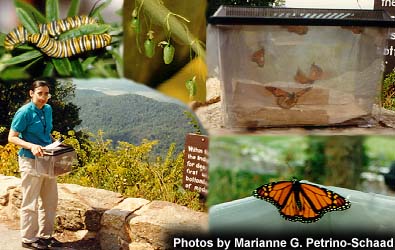
| M o n a r c h W a t c h | |
| Multimedia Gallery |
GALLERY
Introduction
Essays
Photos
Artwork
Monarch
Watch
Classrooms
| Essays : Diary of a Middle-Aged Monarch Watcher | ||
by Marianne G. Petrino-Schaad
August 19, 1997 It took me twenty minutes to dig through tape and styrofoam until I finally reached, and opened, the 8 sauce cups that held 2 caterpillars each. The insects were so very small, maybe 10 to 15 mm apiece, and only 3 to 5 days old. They barely moved. Carefully transferring them with a camel hair paint brush to a plastic "critter cage" was not difficult, but nerve wracking. I gave them milkweed leaves to eat. I put on a pot of coffee, then, with notebook in hand, began to observe. It appeared that one caterpillar's "face" had just fallen off! It swung back and forth in distress. The others stayed still in their new environment, ignoring the only food their species would eat. It seemed a good idea at the time to raise and tag Monarch butterflies. The benefit to conservation would be in the knowledge gained from the annual fall migration of the spectacular butterfly, which was documented by Monarch Watch. Dr. Orley R. "Chip" Taylor of the University of Kansas, director of the project, had gotten hundreds of teachers, students and volunteers started down the same road that I was about to travel. However, only an hour into my attempt, I felt that I had already failed. Thank heaven for the World Wide Web. Calming my panic, I studied the Monarch Watch web page. To my relief I learned that it was quite normal for a caterpillar's face capsule to fall off during a molt. The motion I noted was necessary for it to shed its old skin. As for the others, they exhibited quiescence. This occurs when caterpillars are uncomfortable with their environment. I decided that if I had been shipped in a box from Kansas to Virginia, I'd become quiescent too for a few hours. Armed with my new knowledge, I placed the insects in a safe place. Benign neglect was the order of the first day. |
|
m o n a r c h @ k u . e d u |

 All material on this site © Monarch Watch unless otherwise noted.
All material on this site © Monarch Watch unless otherwise noted.